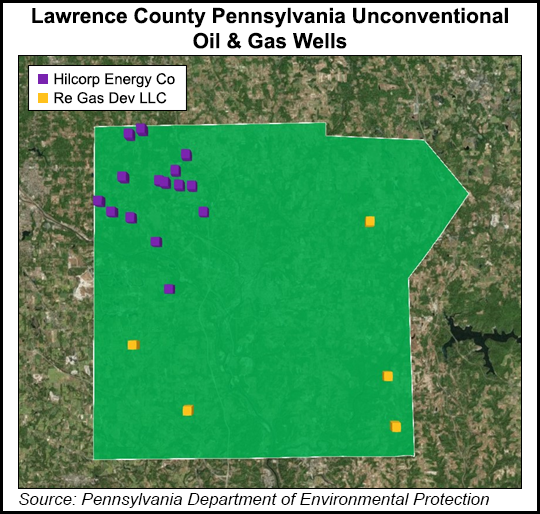Marcellus | E&P | NGI All News Access | NGI The Weekly Gas Market Report | Utica Shale
PA Links Hilcorp Fracking to 2016 Earthquakes; New Regulations Likely
The Pennsylvania Department of Environmental Protection (DEP) has concluded that hydraulic fracturing at a Hilcorp Energy Co. pad in western Pennsylvania triggered a series of micro-earthquakes last year, saying new permitting conditions for all operators will eventually be required in the area.

DEP completed a technical investigation of the seismic events, which occurred in Lawrence County on April 25 and April 26, 2016, that showed a “marked temporal and spatial relationship” between the small quakes and Hilcorp’s well stimulation activities. The agency’s report marks the first time the state has officially linked seismic activity to hydraulic fracturing. The report includes a series of recommendations that Hilcorp has implemented to mitigate “the risk associated with induced seismicity,” said Seth Pelepko, chief of DEP’s Division of Well Plugging and Subsurface Activities.
“I just want to emphasize that these are the agency’s current recommendations,” he said during a webinar on Friday to discuss the report’s findings. “At this time, these recommendations apply to Hilcorp development in the referenced townships. The agency does plan to use this general framework as a foundation for a more comprehensive regulatory program referred to as an ‘area of alternative methods’ for Utica Shale development.”
Seismic monitoring networks detected up to five micro-earthquakes in North Beaver, Union and Mahoning townships near Hilcorp’s four-well pad that ranged in intensity from 1.8 to 2.3 in magnitude. Hilcorp had fractured two of the wells on March 30 and was stimulating the other two at the time some of the earthquakes were recorded on April 25. The company voluntarily idled its operations that day, ceased fracking and shut in two producing wells. It has since resumed production at the site and worked closely with state regulators since.
Pelepko noted that two wells were being zipper fracked on the day of the earthquakes, which creates more pressure in a formation, and is thought to be a key factor in the induced seismic activity. Hilcorp was targeting the Utica Shale in an area where basement rock is shallow and closer to the formation. The Utica is roughly 7,900 feet below the surface there, while the basement rock is between 9,500 and 10,000 feet. As a result, the agency has recommended that Hilcorp stop using zipper fracks in the area on laterals that are separated by less than one-quarter mile.
In its report, DEP also recommends that Hilcorp conduct ongoing seismic monitoring and urges that all detectable seismic events within six miles of any wellbore in the area be reported to the agency within 10 minutes electronically and by phone within one hour. Among other things, there are also more stringent reporting recommendations for a succession of seismic events, which have in the past been linked to human-induced seismic activity. DEP has also requested that other operators follow similar plans in North Beaver, Union and Mahoning townships.
“The plan is to condition future permits in the referenced townships with these recommendations moving forward,” Pelepko said. “It’s important to note that DEP has approved the seismic monitoring plan submitted by Hilcorp and adopted the recommendations included.” Pelepko added that the DEP’s “long-term plan” is to develop area-specific regulations. He said it has already started evaluating geological conditions throughout the oil and gas producing regions of the state to do so.
Pennsylvania has low levels of natural earthquake activity. They’ve been recorded over the years in northwest Pennsylvania — including Lawrence County — and in the southeast part of the state. Pelepko noted that events linked to Hilcorp’s activities occurred in a “seismically active, previously glaciated area.”
Hilcorp’s pad in Lawrence County is about six miles east of another operated by the company in Ohio that state regulators there linked to aseries of earthquakes in 2014. In an unprecedented move at the time, Ohio regulators imposed a set ofpermitting conditions for hydraulic fracturing in horizontal wells near fault lines or areas of previous seismic activity.
Hilcorp has not commented about the Pennsylvania earthquakes, which were not felt by people. Thousands of wells have been drilled in Pennsylvania since shale development began there.
“Pennsylvania’s natural gas producers hold the highest commitment to community, workforce and environmental safety,” said Marcellus Shale Coalition President David Spigelmyer. “The isolated and exceptionally rare nature of this single occurrence reflects the fact that industry-leading best practices are working as designed.”
Induced seismicity and the studies tied to it are relatively new and considered complex. In 2015, the States First Initiative — a collaboration organized by the Interstate Oil and Gas Compact Commission and the Ground Water Protection Council — urged in a150-page reportthat states should develop individualized regulations to deal with activities that can potentially cause earthquakes.
© 2024 Natural Gas Intelligence. All rights reserved.
ISSN © 2577-9877 | ISSN © 1532-1266 | ISSN © 2158-8023 |
